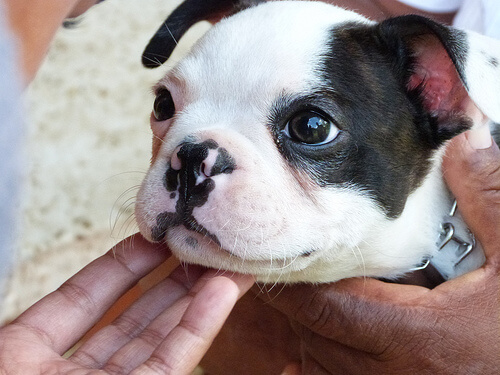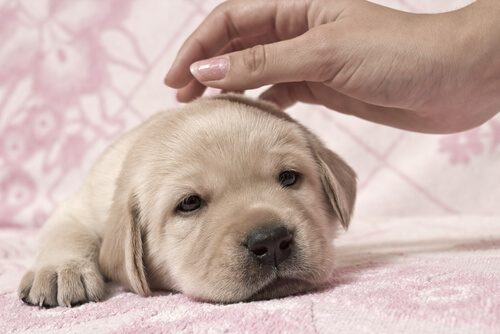How to Calm a Puppy Whining All Night

Knowing how to calm a whining puppy is essential to taking care of your new family member without losing a good night’s sleep.
Which is why today, we are going to discuss eight tips to help you prevent and control your puppy’s insecurities in their new home.
1. Respect the Weaning Age
Unfortunately, it is very common for the weaning age to be disrespected in the trading market. In many cases, puppies are separated from their mothers when they are only 30 days old. Left to her own devices, however, she would naturally stop breastfeeding the puppies when they are between two and three months old.
This practice has serious consequences that threaten the puppy’s physical and emotional balance. On the one hand, the animal does not receive the necessary nutrients and antibodies to fully develop its immune system. In other words, it is vulnerable mainly to viral infections and intestinal parasites.

On the other hand, the puppy feels insecure about being abruptly separated from their mother. Therefore, he may be anxious or intimidated in the face of a radical change in their environment.
When choosing to buy a pedigree dog, it is imperative that you choose well. Ideally, you want to look for a responsible establishment that respects the minimum weaning age of 45 to 60 days.
In the case of adoption, the shelter will be able to inform you about the animal’s age. If the puppy is less than two months old, it is important to ask a veterinarian for guidance about its diet.
2. Consult a Veterinarian and Run the Proper Tests
It is certainly true that, most of the time, puppies whine through the night because they feel insecure. Nonetheless, it is important to rule out any organic causes.
Puppies tend to have a vulnerable immune system. They can also experience cramps or colic on account of the fact that they are growing. The veterinarian will examine the animal and recommend the appropriate tests to find out its state of health.
In the case of rescued animals, it is even more important to check their clinical picture. The majority of abandoned puppies come into contact with many potentially pathogenic microorganisms.
3. Vaccinate and Deworm your Puppy
Puppies must come with their own health cards, including their shot and deworming records. It is important to verify whether this care was given to the animal and make sure it is signed by a responsible veterinarian. The same is true for dogs adopted from shelters.
When it comes to rescuing stray dogs, it is essential to take them to the veterinarian immediately to update their preventive medication.
4. Condition their Environment
Conditioning the environment is a fundamental measure that must be taken, and even more so if the goal is to prevent and calm a whining puppy. When planning to buy or adopt a best friend, it is important to prepare the house for their arrival.
The first thing to keep in mind is the temperature of their environment. Puppies are too young to have the ability to fully regulate their body temperature. It is recommended to keep the temperature between 20ºC and 24ºC, and to avoid direct sunlight and humidity.
Your new puppy should have a bed, a clean bowl with drinking water and a feeder, all of which need to be tailored to the size of the animal. It is also important to choose a clean and quiet location for your pet’s space.
Even though a home’s hygiene must be reinforced, it is not recommended to use chemicals in excess. Especially near the area where the puppy rests and eats. Their small organism can easily be intoxicated or produce allergic processes.
5. Gradual Adaptation
Adaptation is a process and every animal keeps its own pace. The puppy should not be forced to interact with their environment, with other people or animals. When the animal feels safe, he or she will do so by their own free will.
What you can do, however, is help your new child feel encouraged to explore their new home. Offer toys, invite them over for a treat or simply pet them to their heart’s content.
It is recommended to take a puppy home for the first time during the morning. The darkness of the night can leave them feeling more insecure in an unknown place.
6. Simulate their Mother’s Presence
Almost all puppies cry because of the sudden separation from their mothers. Therefore, to calm a whining puppy, you can do your best to simulate their mother’s presence.
A good practice for reassuring your puppy during its first few nights is offering it a garment that carries its mother’s scent. It is not always possible, but it is usually very efficient.
Another trick is to leave a ticking clock either near or underneath your puppy’s bed. The puppy will associate the “ticking” of the clock with its mother’s heartbeat, which will allow both of you get a better night’s sleep.
7. Utilize Pheromones
Another alternative for calming a whining puppy at night is to directly or indirectly administer pheromones.

Pheromone diffusers are a non-invasive option. They are small devices that release small doses of this synthesized hormone into the air. This generates a sense of safety in the animal.
8. Control the Impulse to Console and Soothe your Puppy’s Whining
If you immediately tend to your puppy when it starts whining and allow it to sleep in your bed in an effort to provide more comfort, this can turn into quite an undesirable routine.
If you have already ruled out any possible diseases and have also conditioned your puppy’s environment, it is important to control the impulse to comfort your furry friend’s whining. It may seem cruel, but it is the start of a proper education that establishes the codes of social coexistence.
